TAEKWONDO
Taekwondo is one of the world's most powerful martial arts. It is powerful because of the use of dynamic kicks.
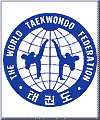 Taekwondo is also one of
the few martial arts that is recognised as an official Olympic sport. While
Taekwondo has been in the Olympics before, the Olympic games in Sidney 2000
was the first time that it was a mainstream event.
Taekwondo is also one of
the few martial arts that is recognised as an official Olympic sport. While
Taekwondo has been in the Olympics before, the Olympic games in Sidney 2000
was the first time that it was a mainstream event.
Taekwondo means "art of the hand and foot fighting". It is more than just that however, it is the scientific use of the body in methods of self-defense. A Taekwondo martial artist's body will gain the ultimate use of its facilities through consistent physical and mental training. It is a martial art that has no equal in either power or technique. Though it is a martial art, its discipline, techniques, and mental training are the foundations for building a strong sense of justice, fortitude, humility and resolve. It is this mental conditioning that separates the true practitioner from the sensationalist content who focus on only mastering the fighting aspects of the art.
Tenets of Taekwondo
- ETIQUETTE
- MODESTY
- PERSEVERANCE
- SELF CONTROL
- INDOMITABLE SPIRIT
Why Grade?
In order to progress in Taekwondo, a student must face ever increasing challenges, whether this be in improving technique or fitness, or personal confidence. The only way to achieve these goals is to progress through the grades and move on to the challenges associated with each step up the Taekwondo ladder. As a student achieves a certain grade, the poomsae ( pattern ) associated with that grade contains the necessary techniques required to develop the mind body of the student. Poomsae ( pattern ) techniques become more difficult and the arrangement more complicated as higher grades are achieved.
Basic Skills
Stances ( sogi )
There are different stances in Taekwondo, and if properly performed will give stability and balance, which is important to execute moves. A good stance is the foundation to build on, being unbalanced either leaning one way or another will lead a student to a disadvantage when facing an opponent.
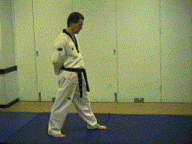 |
This is a walking stance. And is the first one a student will learn. |
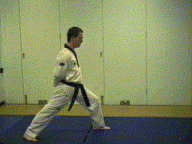 |
This is a forward stance. It is a very stable stance, also it is excellent for blocking techniques. |
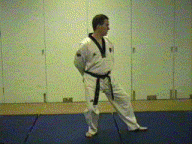 |
This is a back stance. It is good for blocks, strikes and kicks. It is also easy to move into another stance if needed. |
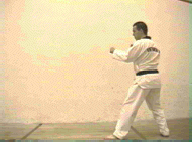 |
This is a fighting stance. It is used when in a fight situation, the student will be on the balls of his\her feet ready to kick or strike if needed. |
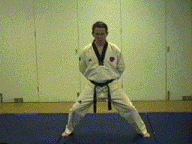 |
This is a sitting stance. It will mainly be used as an exercise, but is very stable for strikes and blocks. |
Here is an overview of some of the kicks ( cha-gi ) used in TaeKwonDo, demonstrated by Master Tom Walton 6th Degree black belt ( W.T.F. style ). Master Tom Walton is the head of the Teuk Soo association.
Kick Preparation
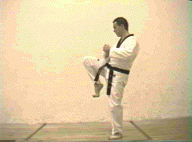 |
The most important part of any kick is the preparation. Most front on kicks start with the knee aimed at the target. |
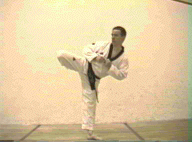 |
For side kicks and turning kicks the knee and the side of the body is aimed at the target |
Front Kick ( Ahp cha-gi )
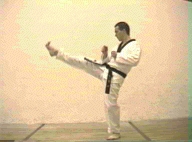 |
This kick is very simple and very effective in use. The knee is first aimed at the target and then the rest of the leg follows through, and this is done as quickly as possible. The target must be hit by the ball of the foot, meaning that at the moment of impact the toes are pulled back towards the body. |
| To see an animation of this kicking technique, please click here. |
Turning Kick ( Dolryo cha-gi )
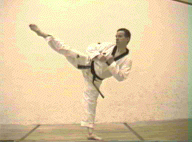 |
This kick is a bit more difficult, due to the preparation and technique to perform it correctly. The knee is first aimed at the target and then followed through with the thigh and hips to generate momentum and then the rest of the leg follows through. The target is hit with the top part of the foot and lower shin of the leg. The supporting leg is pivoted 120 to 180 degrees. |
| To see an animation of this kicking technique, please click here. |
Side Kick ( Yop cha-gi )
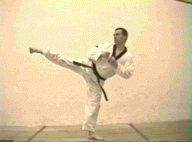 |
This kick is executed with the body side on to the target. The knee is first aimed at the target and with the whole body twisted sideways to the target, the leg is extended out straight and the target is hit with the edge of the foot with the toes pulled back.The supporting leg is pivoted 180 degrees to the target. |
| To see an animation of this kicking technique, please click here. |
Axe Kick ( naeryo cha-gi )
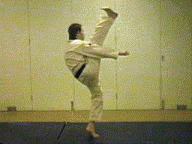 |
This kick can be executed in two main variations, bent knee or straight knee kicking. The knee is brought up as close to the shoulder as possible and the whole leg is brought down as rapidly as possible. The target is hit with the sole or heel of the foot. |
| To see an animation of this kicking technique, please click here. |
Outer Crescent Kick ( bakkat huryo cha-gi )
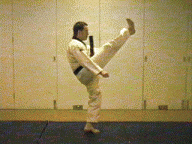 |
This kick is used up close to a target. The knee is first swept up and across the front of the body keeping the leg bent, until it reaches its peak, and then the rest of the leg follows through with the target being struck with the outside edge of the foot. |
| To see an animation of this kicking technique, please click here. |
Jump Half Turning Kick ( twi-o bandal cha-gi )
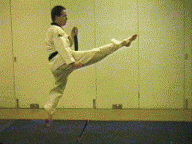 |
This is a very powerful kick, because the full weight of the body is in mid air striking the target. This kick starts off as a cross between a front kick and a turning kick. The target is hit while in the air, with the instep of the foot and the body is at 45 degrees to the target. |
| To see an animation of this kicking technique, please click here. |
Reverse Turning Kick ( bandae dollyo cha-gi )
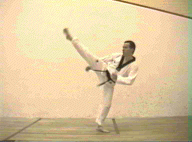 |
This kick is an exact reverse of a normal turning kick. You start by turning your upper body, facing your back to the target and pivoting on the supporting leg, so that the heel faces the target, and then look over the shoulder while following through with the thigh and leg. The heel or sole of the foot strikes the target. |
| To see an animation of this kicking technique, please click here. |
Instep Reverse Turning Kick ( baal-dung bandae dollyo cha-gi )
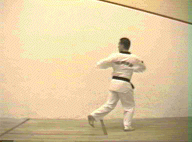 |
This kick will start with an instep towards the target and is used to feint an opponent. The kick is the same as before, but with an instep to confuse your opponent. |
|
To see an animation of this kicking technique, please click here. |
Patterns ( poomsae )
W.T.F. Taekwondo follows the Tae-Kook style of patterns. Translated from the Chinese characters, Tae means greatness, and Kook means eternity. The combination of these two words makes it clear that eastern philosophy is very much present. Tae-Kook is the essence of all that is, without form, without a beginning, and without an end. Tae-Kook is the essence of all that is. They are named as follows;
| 1 ( il chang ) | 2 ( le chang ) | 3 ( sam chang ) | 4 ( sa chang ) |
| 5 ( oh chang ) | 6 ( yuk chang ) | 7 ( chil chang ) | 8 ( pal chang ) |
Patterns are an important part of taekwondo and each belt gained requires the student to have learnt the poomsae for that grade, also importantly the student must still remember the previous patterns and practise them when ever possible. A student must be focused to be clear of mind and body, possess good balance to perform the movements correctly, use force in the moves and kihop for control of breathing-energy release.
Here are a few moves taken from pattern 1 ( il-chang )
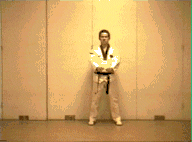 |
This is the starting position of the pattern and is known as- junbi seogi. The student will take this stance and will not start the pattern until instructed. |
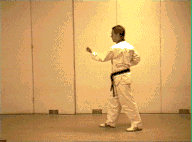 |
This is an inward reverse block and is known as- momtong an maggi. It is used to block a strike from an opponent. |
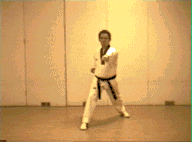 |
This is a mid section reverse punch in a forward stance and is known as- ap koobi seogi, bandae jireugi. This is a powerful strike in a strong stance. |
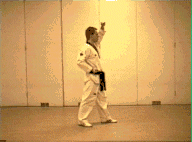 |
This is an obverse high section block in a walking stance and is known as- ahp seogi, eolgool maggi. The block is used against high section strikes. |
| Click here #1 or here #2 to see pattern il-chang performed by Master Tom Walton. | The file size is 2.7Mb for #1 high quality and 1.1Mb for #2 low quality and may take a few minutes to load depending on your connection. After loading, to save right click with your mouse and save as .?. to a directory of your choice. |
Dan grade
When a student gains their black belt, the learning of patterns does not end there. To reach the next level of Dan grade they must perform Dan grade patterns and they are as follows;
| Koryo ( Korea ) | Kum-Kang ( Diamond ) |
| Tae-beck ( mountain-symbol of the country ) | Pyongwon ( Plain ) |
| Sipjin ( Ten ) | Jitae ( Earth ) |
| Chonkwon ( Heaven ) | Hansoo ( Water ) |
| Ilyo ( Unity ) |
Here are a few moves taken from Taebeck.
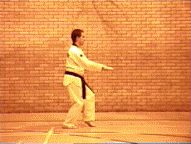 |
This is a double palm block in a tiger stance. The stance protects the groin and the palms block the attacking strike. |
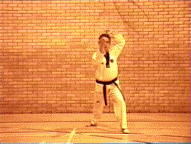 |
This is a forward stance with a high rising knife hand block and an inward knife hand strike. This is a strong stance with a countering block/strike. |
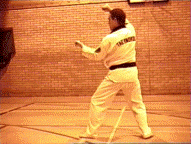 |
This is an outer and high rising block in a back stance. It is used to block an attack before countering. |
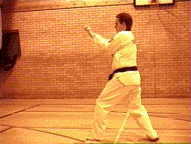 |
This is an upset punch. This can be best be described as pulling the attacker towards you then punching in an upward arc. |
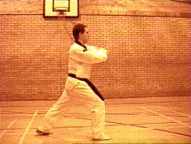 |
This is a mid section elbow strike in a forward stance. The forward stance is strong to retaliate an attacker with an elbow strike to the body. |
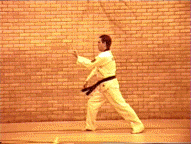 |
This is an outer and lower block in a forward stance. This can be used to block a double strike from an opponent. |
| Click here #1 or here #2 to see Taebeck performed by Master Tom Walton. | The pattern is 3.4Mb for #1 high quality and 1.2Mb for #2 low quality and will take a few minutes to load depending on your connection. After loading, to save right click with your mouse and save to .?. a directory of your choice. |
These are just a few of the techniques used in Taekwondo, to create a powerful and dynamic martial art.
For further details please contact your nearest Teuk Soo Club and speak to the instructor.
Click here to go back to the homepage
| © Teuk Soo 1997 |